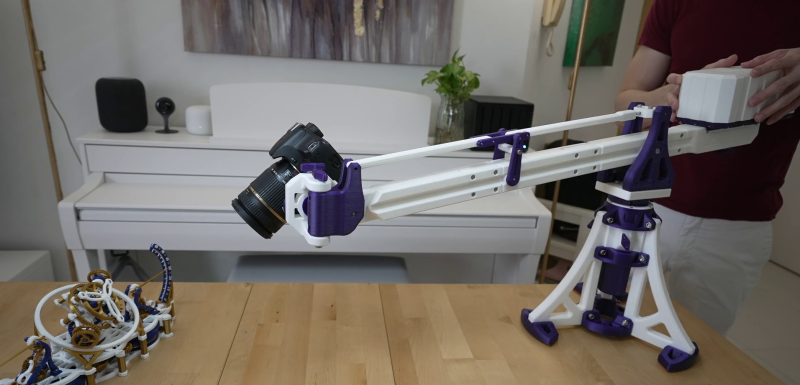If you’ve ever tried to document a project on your workbench with photos or videos, you know the challenge of constantly moving tripods to get the right shot. [Mechanistic] is familiar with this frustration, so he built a small desktop camera crane.
Heavily inspired by [Ivan Miranda]’s large camera crane, this build scales it down and mainly uses 3D printed parts. The arm of the crane can pivot along two axes around the base, uses a parallel bar mechanism to keep the camera orientation constant through its vertical range of motion. The camera mount itself allows an additional 3 degrees of freedom to capture any angle and can mount a DSLR or smartphone. To offset the weight of the camera, an adjustable counterweight is added to the rear of the arm. Every axis of rotation can be locked using thumbscrews.
We can certainly see a crane like this being useful on our workbench for more than just camera work. You could create attachments for holding lights, displays, multimeters, or some helping hands. For some tips on creating an engaging project video check out [Lewin Day]’s excellent video on the subject.















This looks great, but why 3D print the arm in sections then run a steel rod through it when you could simply use a piece of aluminum tubing or t-slot with a few fittings?
When all you have is a 3D printer and a spool of filament, this is the likely result.
When all you have is a hammer, everything looks like a nail.
True, but using 3D printer for something simple like this arm is a waste of time and money, simple wooden arm would be cheaper and faster to produce. No complaints on other parts, really nice build, but arm can be simplified.
I’d much rather print this than do woodworking in my apartment.
this is a really novel take to me. i personally always try to design my parts using wood or metal for arms and big walls…using a little hacksaw on a 3-foot piece of dowel is infinitely preferable to me compared to doing a 15 hour print where 3 separate 1 hour prints would do. especially since i’m kind of skeptical about my printer’s ability to run for 15 hours without a glitch, nevermind the babysitting. and of course it’s forced on me because my printer’s build area is roughly 100mm x 100mm x 200mm and it gets dicier the higher you go, depending…
i’m curious, is your attitude a hypothetical one, or do you actually have a 3d printer, Clyde?
For many people, it can really be that they don’t have other tools and no space for them. A 3D printer does not take much space, makes no dust and can be a poor substitute for a lot of simpler tools :)
This is the same with developing software. Everyone is using web technologies to develop apps and everyone agrees it’s a bad choice, but it’s so much simpler. This looks the same, if I wanted to make this arm. Either I buy the plans and start printing or I buy the plans and get in the car to go find supplies, that don’t fit my car that well, then I’d probably should have some sort of workshop and tools to do the cutting. So 3d printing is a “bad choice” but quite a simpler one.
The main benefit of building software with web technology is that it makes it easier to get it in front of the most eyeballs. If you have no intention/need for wide support, there is little impetus to build with web technology first or at all. See many large FOSS Linux-only products.
While I agree its not how I would do it, its a perfectly valid method, at least from a glance, and being all 3d printed externally has a very unified and tidy look to it.
Though for me sod pretty if I’m hanging even my backup camera and cheapest lens off it I want solid and functional over looks – finding halfway decent lens at a good price takes effort and time searching, but this looks perfectly good enough in construction from a skim through I wouldn’t worry about using it.
Aesthetic could be another reason